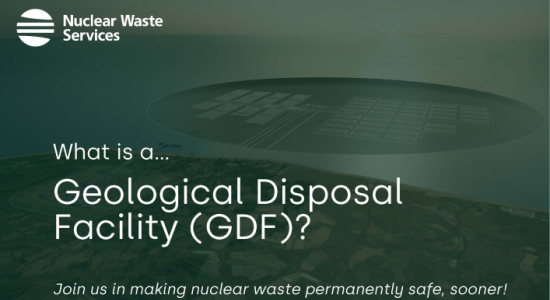Geological disposal involves isolating radioactive waste deep underground, inside a suitable rock volume to ensure that no harmful quantities of radioactivity ever reach the surface environment. A GDF will be a highly engineered structure consisting of multiple barriers that will provide protection over hundreds of thousands of years.
Has any region been selected for a GDF?
At this stage, no host site for a GDF has been identified and discussions are happening with communities around England and Wales. Working Groups and Community Partnerships have been formed in different areas of the country to start exploring whether a GDF is right for their area and whether their area is right for a GDF. This will be a consent-based, partnership approach, with Right of Withdrawal by the community right up to a Test of Public Support.
What is radioactive waste and where does it come from?
Radioactive waste is radioactive material for which we have no further use. Most comes from the generation of electricity using nuclear power but it is also a by-product of many medical and industrial processes, research and defence activities that make use of radioactivity and radioactive materials.
What waste is destined for geological disposal?
A GDF will take higher activity waste. This consists of High Level Waste, Intermediate Level Waste and a small amount of Low Level Waste which is not suitable for disposal at existing surface facilities. For planning purposes, we consider wastes from existing uses of radioactive materials, as well as wastes that would be generated from new nuclear power stations. We also include various nuclear materials in our planning that are not currently classified as waste, since these would need to be managed through geological disposal if it were decided at some point that they had no further use.
A short film that describes our mission to find a suitable site in a willing community for a Geological Disposal Facility (GDF).
Prof Claire Corkhill, an independent Nuclear Waste Expert from Sheffield University, introduces the science behind geological disposal.
Where is the waste now?
Radioactive wastes that will be disposed of in a GDF are currently being packaged in specially engineered containers and stored at over 20 nuclear sites around the country. The stores are designed to withstand severe weather and earthquakes.
Take a trip 1km underground, several decades from now, to explore a Geological Disposal Facility (GDF).
Radioactive Waste Management (RWM) is a public organisation established by Government and responsible for planning and delivering geological disposal of radioactive waste in the UK. Our vision is to create a safer future by managing radioactive waste effectively, to protect people and the environment.
Why can’t we leave the waste where it is?
Surface stores, whilst designed to be safe for around 100 years, don’t provide a permanent solution. They need to be continually monitored to keep the waste secure and periodically refurbished to prevent the waste from being exposed to the effects of the weather. Eventually, they will need to be replaced, or the waste moved elsewhere. Surface storage is therefore less safe than geological disposal for the long term, and would end up being much more labour intensive and costly in the long run.
This animation explaining our mission to deliver a Geological Disposal Facility (GDF) in the UK.
When will a GDF be built?
Construction will only start when a suitable site is identified, all the necessary consents and permits have been obtained and the host community has indicated its willingness to host the facility through a Test of Public Support. The latest planning assumption is that a GDF could be ready to receive intermediate level waste between 2050-2060, with high level waste and spent fuel from 2075. Filling a GDF with waste and then closing it, once full, will run into the next century.
- 80 views





